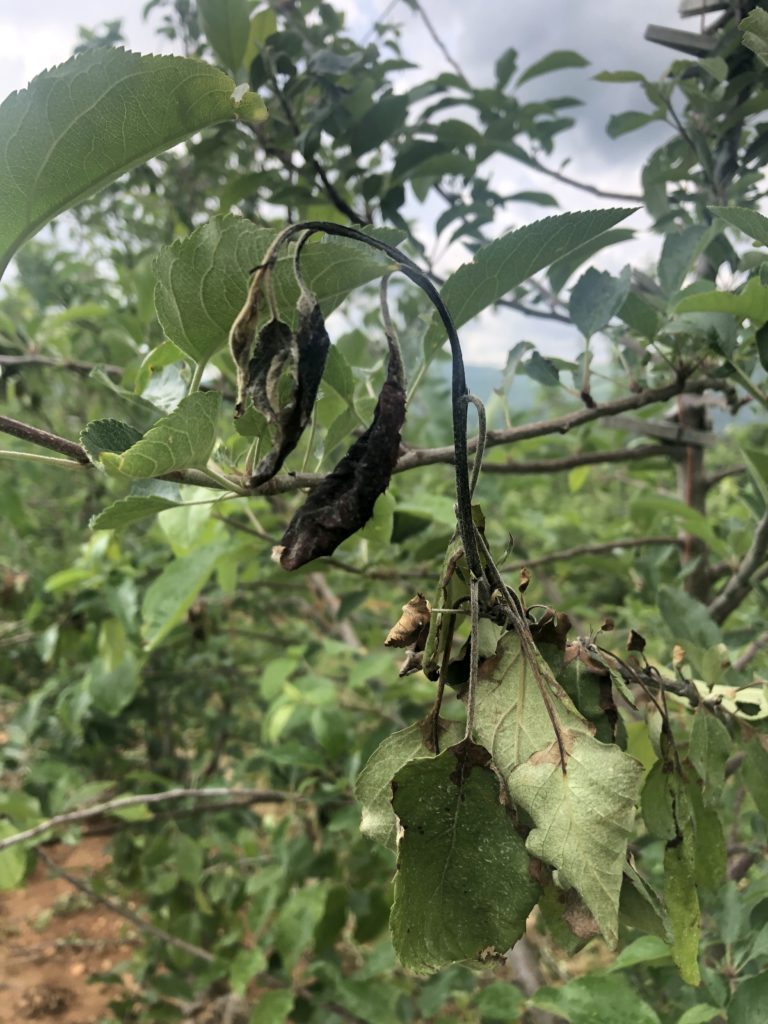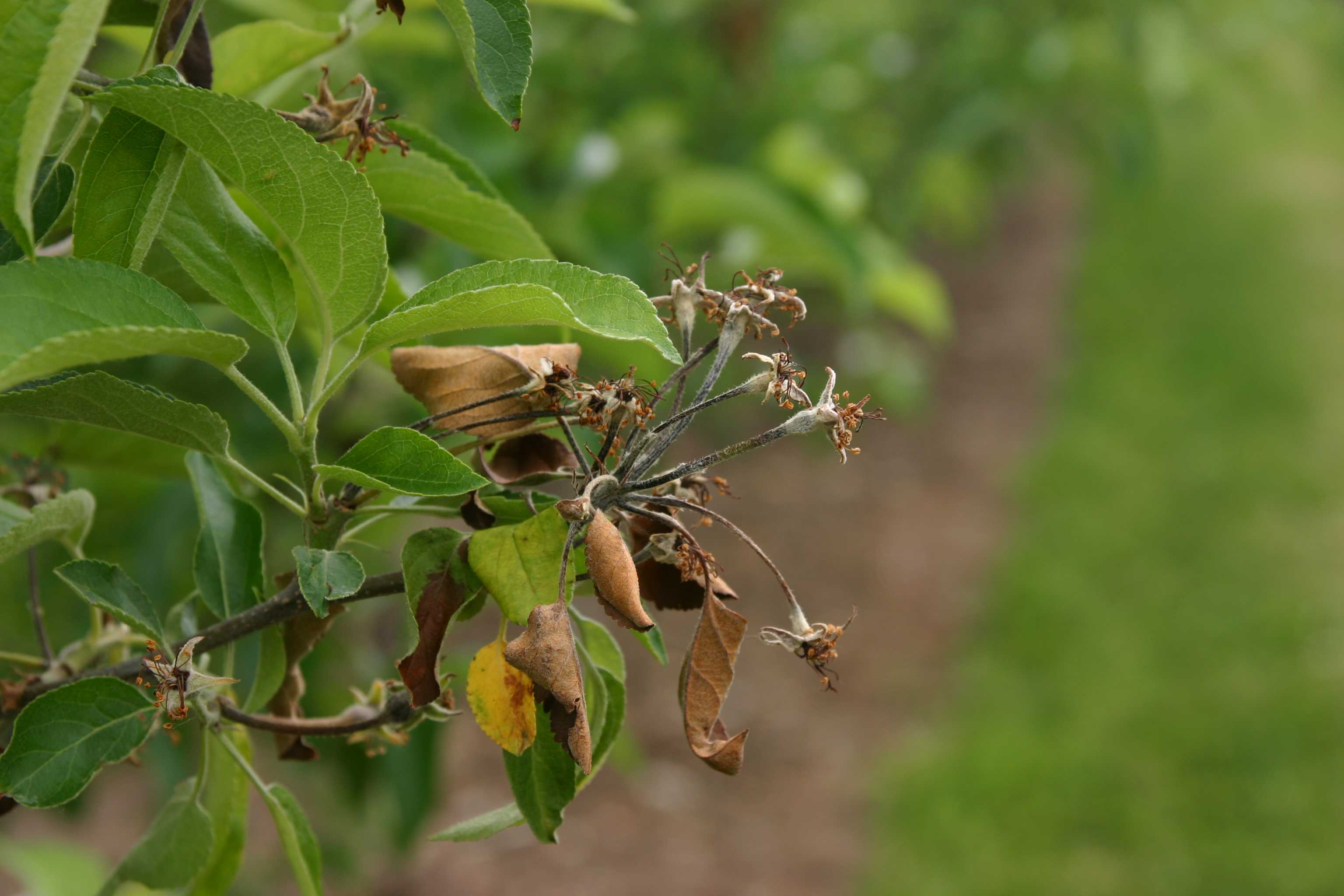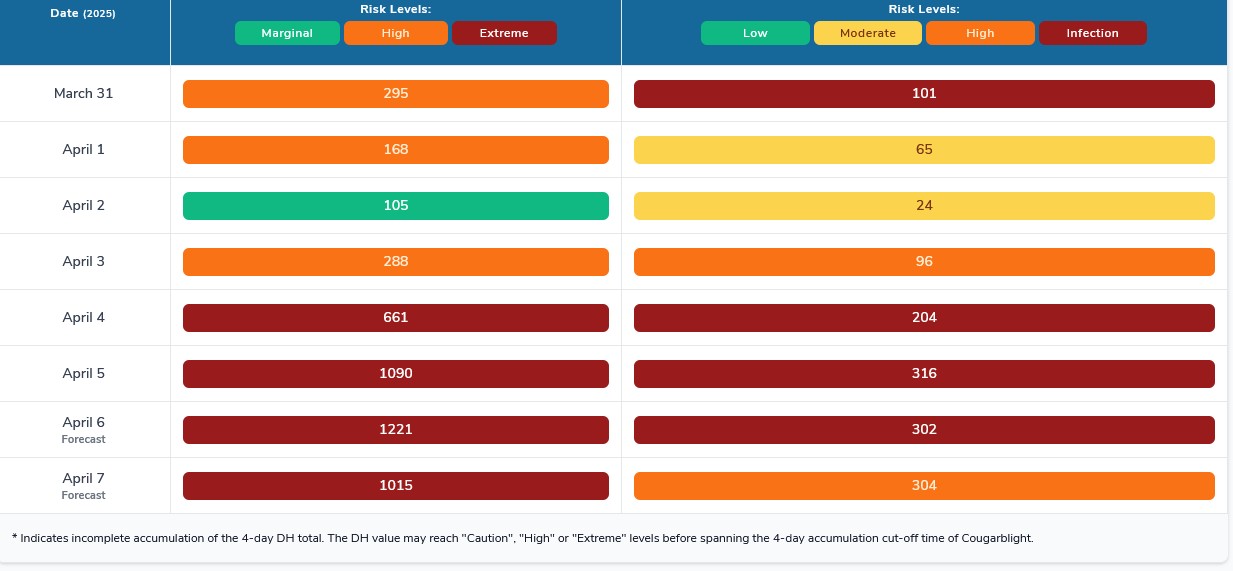2025 Apple Disease Update: Late Bloom and Petal Fall
go.ncsu.edu/readext?1066249
en Español / em Português
El inglés es el idioma de control de esta página. En la medida en que haya algún conflicto entre la traducción al inglés y la traducción, el inglés prevalece.
Al hacer clic en el enlace de traducción se activa un servicio de traducción gratuito para convertir la página al español. Al igual que con cualquier traducción por Internet, la conversión no es sensible al contexto y puede que no traduzca el texto en su significado original. NC State Extension no garantiza la exactitud del texto traducido. Por favor, tenga en cuenta que algunas aplicaciones y/o servicios pueden no funcionar como se espera cuando se traducen.
Português
Inglês é o idioma de controle desta página. Na medida que haja algum conflito entre o texto original em Inglês e a tradução, o Inglês prevalece.
Ao clicar no link de tradução, um serviço gratuito de tradução será ativado para converter a página para o Português. Como em qualquer tradução pela internet, a conversão não é sensivel ao contexto e pode não ocorrer a tradução para o significado orginal. O serviço de Extensão da Carolina do Norte (NC State Extension) não garante a exatidão do texto traduzido. Por favor, observe que algumas funções ou serviços podem não funcionar como esperado após a tradução.
English
English is the controlling language of this page. To the extent there is any conflict between the English text and the translation, English controls.
Clicking on the translation link activates a free translation service to convert the page to Spanish. As with any Internet translation, the conversion is not context-sensitive and may not translate the text to its original meaning. NC State Extension does not guarantee the accuracy of the translated text. Please note that some applications and/or services may not function as expected when translated.
Collapse ▲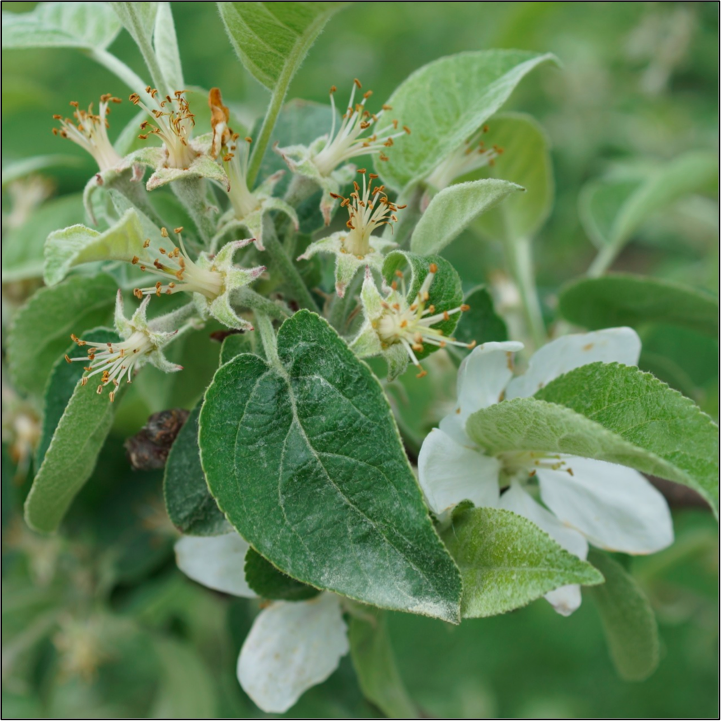 On many cultivars in Western NC, petal fall is occurring or should be approaching this week. Petal fall is about the time we start to think about beginning management for Glomerella leaf spot and bitter rot in North Carolina. However, given the cooler weather predicted for this week, I’d encourage you to start to tighten up your fungicide application intervals, but focus on fungicides primarily aimed for for managing early season diseases such as scab, powdery mildew and cedar apple rust. Setting a green tip date on March 10, 2025 in Edneyville NC, ascospore maturity is 81% and 78% of ascopores of the apple scab fungus have been released. What are ascospores and what does this mean? Ascospores are the sexual spores of the apple scab pathogen, Venturia inaequalis, that overwinter in leaf litter on the ground. These spores cause primary (the initial) apple scab infections. Starting at greentip, ascospores start to mature and release during rain events. By the end of bloom (now-ish) most of these spores have matured, and when a rain occurs will be released. As of April 7, 2025, there have been 7 days with apple scab infection events.
On many cultivars in Western NC, petal fall is occurring or should be approaching this week. Petal fall is about the time we start to think about beginning management for Glomerella leaf spot and bitter rot in North Carolina. However, given the cooler weather predicted for this week, I’d encourage you to start to tighten up your fungicide application intervals, but focus on fungicides primarily aimed for for managing early season diseases such as scab, powdery mildew and cedar apple rust. Setting a green tip date on March 10, 2025 in Edneyville NC, ascospore maturity is 81% and 78% of ascopores of the apple scab fungus have been released. What are ascospores and what does this mean? Ascospores are the sexual spores of the apple scab pathogen, Venturia inaequalis, that overwinter in leaf litter on the ground. These spores cause primary (the initial) apple scab infections. Starting at greentip, ascospores start to mature and release during rain events. By the end of bloom (now-ish) most of these spores have matured, and when a rain occurs will be released. As of April 7, 2025, there have been 7 days with apple scab infection events.
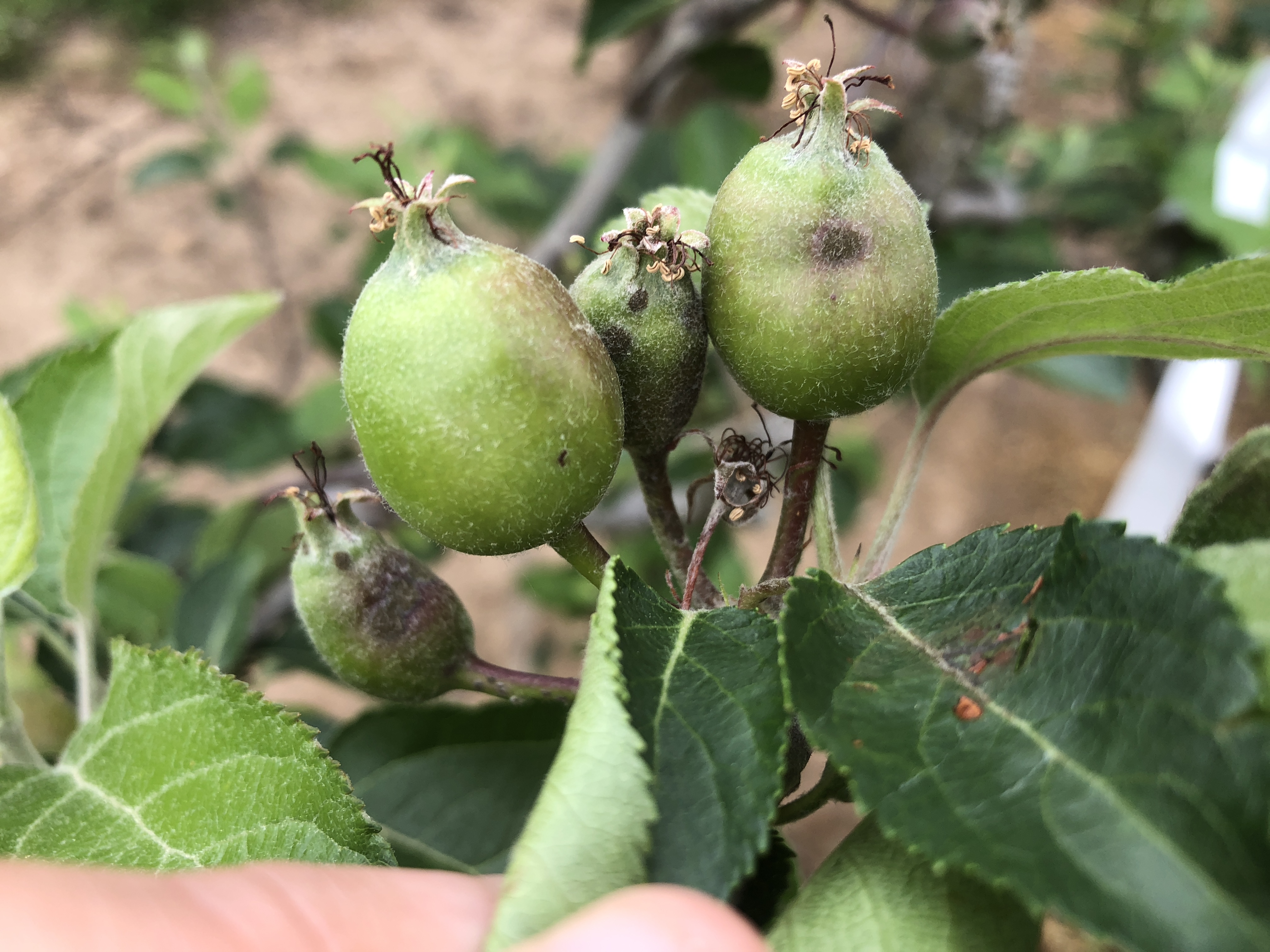 There are several fungicide options for managing apple scab that I would consider applying for scab at the late bloom/petal fall timing including: mancozeb, Inspire Super, Cevya, Aprovia, Miravis, Excalia, Luna Flex, and Axios. Before you start screaming at me that there are others, and I completely left out the strobilurins, I did that on purpose. Those fungicides including Luna Sensation, Merivon, Flint Extra, and Sovran, should be saved for GLS and bitter rot. Even though Sovran isn’t highly efficacious again bitter rot and Glomerella in apple, it’s a FRAC 11 and has the same mode of action as the other strobilurins that I listed. Certainly what you decide to apply depends on several factors including resistance history, budget, and pressure from other diseases. However, given that a scab infection is predicted for April 7th and it’ll rain on that day, you may want to consider Inspire Super or Cevya at this timing. In addition to kickback control of scab, these options will be good to excellent at controlling mildew, rust, and Marssonina leaf blotch. As we’ve learned through our research Marssonina can be controlled with applications of efficacious fungicides from bloom through approx. second or third cover. Remember for resistance management to mix a half rate of mancozeb with whatever single site fungicide you choose.
There are several fungicide options for managing apple scab that I would consider applying for scab at the late bloom/petal fall timing including: mancozeb, Inspire Super, Cevya, Aprovia, Miravis, Excalia, Luna Flex, and Axios. Before you start screaming at me that there are others, and I completely left out the strobilurins, I did that on purpose. Those fungicides including Luna Sensation, Merivon, Flint Extra, and Sovran, should be saved for GLS and bitter rot. Even though Sovran isn’t highly efficacious again bitter rot and Glomerella in apple, it’s a FRAC 11 and has the same mode of action as the other strobilurins that I listed. Certainly what you decide to apply depends on several factors including resistance history, budget, and pressure from other diseases. However, given that a scab infection is predicted for April 7th and it’ll rain on that day, you may want to consider Inspire Super or Cevya at this timing. In addition to kickback control of scab, these options will be good to excellent at controlling mildew, rust, and Marssonina leaf blotch. As we’ve learned through our research Marssonina can be controlled with applications of efficacious fungicides from bloom through approx. second or third cover. Remember for resistance management to mix a half rate of mancozeb with whatever single site fungicide you choose.
In addition to fungal diseases and blossom blight, around the petal fall timing is when you want to start thinking about your first application of prohexadione calcium. As BASF is not longer making Apogee, Kudos will likely be more available for purchase this season. In order for shoot blight to occur, their must be inoculum present within or near an orchard (i.e. there must be a local inoculum source). Thus, even just a few blossom blight infections can serve as a strong catalyst for shoot blight infection. Shoot blight is the result of infection to young, emerging leaf tissue. Injury to this susceptible leaf tissue provides the means for bacteria to invade and progress down young shoots. Insects with sucking or piercing mouth parts, or other types of wounds created from environmental conditions (e.g. hail, wind, soil abrasion, etc). At least two applications of Kudos should be applied during the season for shoot blight management. For mature trees a 12 oz/100 gal rate is recommended between the period of petal fall and 1-3″ shoot growth. You’ll want to follow up with a second application 14 days later. For trees less than 5 years old in which you are trying to fill the canopy, make applications at the same timings but at a reduced rate of 2-3 oz Kudos plus 1 oz Actigard/100 gal OR 6 oz/100 gal Kudos. Make sure to follow label guidelines on the addition of water softeners and penetrating adjuvant when making an application. Also, do not apply calcium in tank mixture with ProCa.
Lastly, many orchard blocks still have open flowers, which mean the potential for blossom blight exists. Just to clear up a few things EIP model on NEWA. EIP is an acronym for Epiphytic Inoculum Potential. In order for blossom blight to occur, bacterial populations of the fire blight pathogen, Erwinia amylovora, must build on the stigmatic surface of the flower. Generally speaking, EIP is a function temperature of temperature and time and is corresponds to the amount of Erwinia on the stigma. These bacteria are not causing infection on the stigmatic surface. However, when the EIP is 100 or greater and there is a wetting invite, infection can occur. These models however are not perfect and thus if the EIP number (that number inside the colored box on NEWA) is slightly below 100, infection can still occur, just less likely. For example, let’s take a quick look at blossom blight risk in Polk County last week:
This table shows predicted blossom blight infection events in Polk County NC if no streptomycin application had been made in the past week. In addition to the EIP number being over 100, the following conditions need to be met:
- a certain number of heat units must accumulate during bloom for a threshold level of inoculum to be reached; and
- a wetting event is necessary after this point to wash the bacteria to their infection sites; and
- the average temperature is above 60F
If all three events occur then there’s an infection/extreme risk (dark red), if two conditions are met there’s a high risk (orange), if one condition is met there’s a moderate risk (yellow), and if no conditions are met there’s a marginal risk of blossom blight (green). On April 3, a high risk is predicted only because the EIP number is 96 and does not meet the 100 threshold value. As grower who hopefully now understand the model outputs a bit better, you’d likely be very concerned about an infection that day as 96 is very close to 100. If the color code had been orange and the EIP number inside had been “36” instead of “96” you may have been less concerned as bacterial populations were not near the threshold.
As of April 6, 2025 the following Blossom Blight Infections are predicted:
Henderson Cty, NC: If streptomycin was last applied on April 4, 2025 there was an infection/extreme risk for blossom blight on Sunday April 6th. Streptomycin may provide up to 48 hours of post infection activity, but 24 hours after an infection is ideal. Try to get an application of the high rate of streptomycin + adjuvant on ASAP but no later than Tuesday April 8th. If you applied streptomycin last on April 5th, right now you are in the clear for an infection events through April 11, 2025.
Wilkes Cty, NC: If streptomycin was last applied on April 4, 2025 there was an infection/extreme risk for blossom blight on Sunday April 6th and there is a high risk for infection on Monday April 7th. Streptomycin may provide up to 48 hours of post infection activity, but 24 hours after an infection is ideal. Try to get an application of the high rate of streptomycin + adjuvant on ASAP but no later than Tuesday April 8th. If you applied streptomycin last on April 5th, right now you are in the clear for an infection events through April 11, 2025.
Polk Cty, NC: If streptomycin was last applied on April 4, 2025 there was an infection/extreme risk for blossom blight on Saturday April 5th and Sunday April 6th and there is a high risk for infection on Monday April 7th. Streptomycin may provide up to 48 hours of post infection activity, but 24 hours after an infection is ideal. Make sure to get an application of streptomycin at the high rate on Monday and be sure to include an adjuvant. If you applied streptomycin last on April 5th, there was a high risk for infection on April 6th, but the EIP value was only 56. You’re likely in the clear through April 11th.



